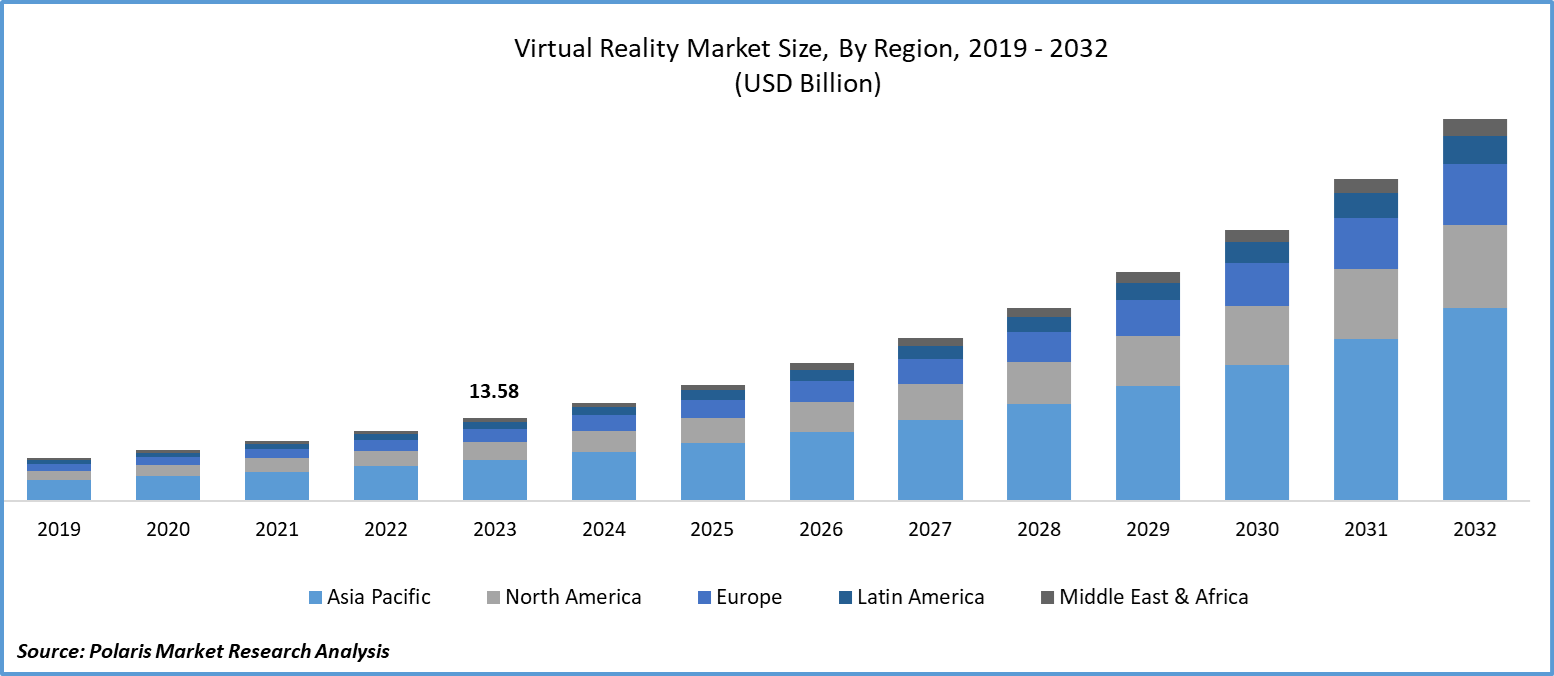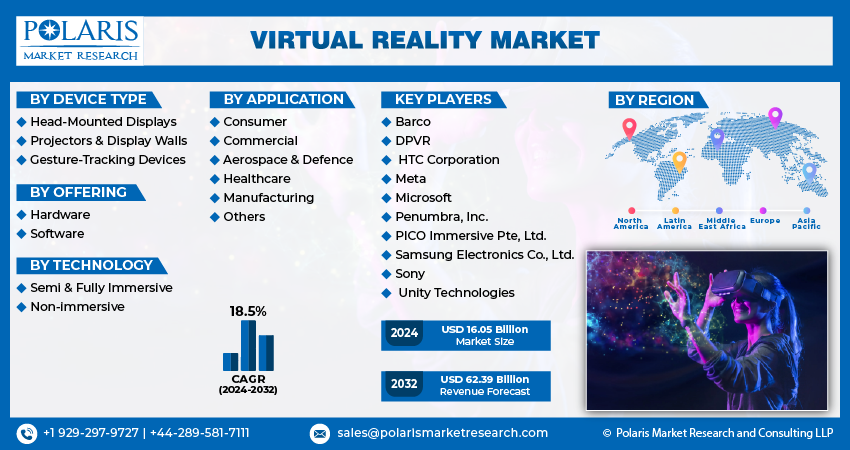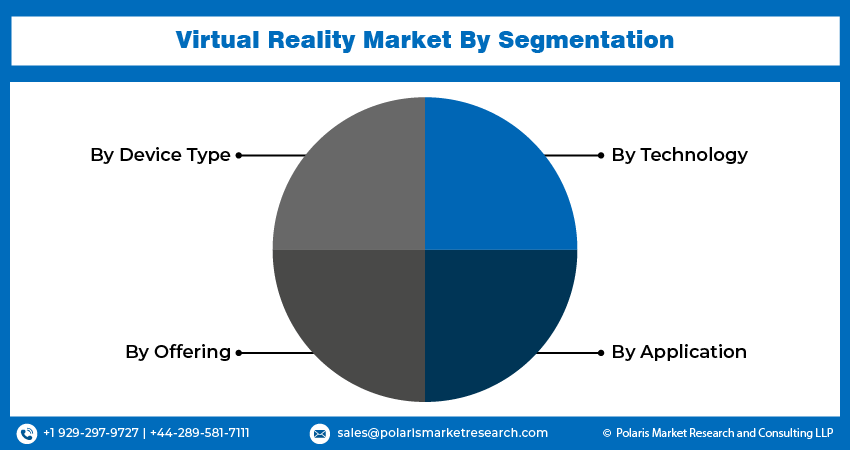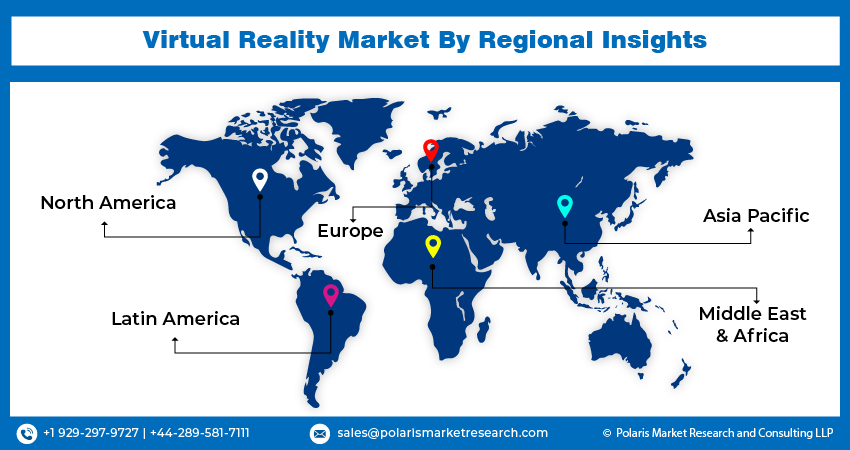
Virtual Reality Market Share, Size, Trends, Industry Analysis Report
By Device Type, By Offering (Hardware, Software); By Technology (Semi & Fully Immersive, Non-immersive); By End-Use, By Region; Segment Forecast, 2024- 2032
- Published Date:May-2024
- Pages: 119
- Format: PDF
- Report ID: PM4921
- Base Year: 2023
- Historical Data: 2019-2022
Report Outlook
Virtual Reality Market size was valued at USD 13.58 billion in 2023. The market is anticipated to grow from USD 16.05 billion in 2024 to USD 62.39 billion by 2032, exhibiting the CAGR of 18.5% during the forecast period
Virtual Reality Market Overview
The Virtual Reality Market is witnessing significant growth as it allows individuals to immerse themselves in a realistic three-dimensional world. This captivating experience is made possible through the use of VR technology and devices like VR headsets, glasses, gloves, and bodysuits. In addition to revolutionizing the gaming and entertainment industries, VR technology is also being extensively utilized in instructional training for professionals in fields such as engineering, mechanics, aviation, defense, and various industrial sectors. As a result, the market for virtual reality is experiencing significant growth.

To Understand More About this Research: Request a Free Sample Report
For instance, in May 2024, Liang'an Xu has revolutionized the world of VR technology with his creation of a New Universe Landscape, the VR Development Intelligent Service System, has paved the way for the advancement and utilization of VR technology through its impressive capabilities. This software offers developers a comprehensive VR development solution in one convenient package.
The utilization of virtual reality technology has been steadily increasing in both personal and professional settings. The emergence of 5G technology is anticipated to tackle certain obstacles by facilitating optimized distribution of processing capabilities. The improved performance of 5G allows for quicker and more dependable connections, ultimately enhancing the user's VR experience.
With higher data transfer rates and reduced latency, VR applications become more responsive, while the enhanced visuals enable the streaming of high-resolution content and intricate 3D graphics in real time. The capabilities of 5G present new possibilities for VR, including real-time cloud rendering and edge computing, which enable the development of complex and data-intensive applications like virtual tourism and smart city simulations.
Virtual Reality Market Dynamics
Market Drivers
Rising Technological Advancements
Virtual Reality (VR) technology stands as a key component of the metaverse, offering immersive encounters that blend the boundaries between the physical and digital realms. In order to delve into the metaverse, individuals must possess immersive tools such as VR headsets, smart glasses, AR devices, or even mobile devices like smartphones and tablets. While VR serves as a conduit for users to engage with the metaverse. The metaverse functions as a multifaceted platform that integrates VR among its array of features, facilitating a seamless, cross-platform environment for global interaction within the virtual realm
Rising Adoption in Education and Corporate Training
The rising adoption of virtual reality in education and corporate training is on rise as it has the potential to enhance engagement and improve knowledge retention rates, while also allowing employees to undergo training in safer, more cost-effective, and reproducible manners. VR empowers employees to acquire knowledge through hands-on experience. It also enhances comprehension of intricate concepts, subjects, or theories, facilitating a deeper understanding. Minimizes interruptions during the learning process. Stimulates students' imaginative thinking. Enhances learners' effectiveness in acquiring knowledge.
Market Restraints
Display Latency Issues
The effectiveness of virtual reality devices relies on display latency, plays a crucial role in determining their overall performance. Latency, which refers to the time delay between user input and the corresponding visual response in the virtual reality environment, has the ability to disrupt the seamless immersion that virtual reality aims to provide. Even a small delay can result in motion sickness, discomfort, and a noticeable disconnection from the virtual world.

Report Segmentation
The market is primarily segmented based on device type, offering, technology, application, and region.
|
By Device Type |
By Offering |
By Technology |
By Application |
By Region |
|
|
|
|
|
To Understand the Scope of this Report: Speak to Analyst
Virtual Reality Market Segmental Analysis
By Device Type Analysis
The Head-Mounted Displays segment dominated the market, largely attributable to its ability to offer versatile applications not only in virtual reality gaming but also in military, medical, and engineering fields. The speed at which the program converts your head position information into visual data is crucial for creating an immersive virtual experience. To accurately track your head's position and translate it into other data, a reliable head tracking technology is essential for your HMD. Moreover, additional devices can be incorporated such as, a voice recognition system using voice commands to interact with the virtual environment, or a glove connected to the computer can allow users to move objects within the virtual world.
The Gesture-Tracking Devices segment is projected to grow at a CAGR during the projected period, by enhancing the virtual reality (VR) experience that facilitates more intuitive and seamless interaction. Typically, gesture recognition utilizes sensors to gather user data and machine learning algorithms to interpret and respond to human actions. The VR hardware for gesture recognition encompasses VR projectors, processors, sensors, expansive displays, and multi-screen projection systems. Additionally, numerous companies are actively working on enhancing the effectiveness of sensors and processors employed in VR systems, aiming to deliver a highly immersive experience to users.
By Technology Analysis
The Semi & Fully Immersive segment accounted for the largest market share owing to continuous increase in demand for virtual reality HMDs for institutional and industrial purposes. This replicates real-life environments in a virtual setting, making it valuable for intricate tasks and strategic planning. This technology involves the utilization of sophisticated emulators, powerful personal computers, and high-resolution displays.
The non-immersive segment is anticipated to grow at the fastest CAGR as it provides users with a virtual environment generated by a workstation, rather than an immersive, realistic world. This technology is gaining adoption due to its efficient network management and widespread availability. Input devices like controllers, keyboards, mice, and displays are essential for non-immersive systems to operate effectively on computers and consoles, eliminating the need for a completely new system investment.
By Offering Analysis
The software segment dominated the market, as it allows users to experience a simulated three-dimensional environment by utilizing computer programs and applications. Through the integration of advanced technologies, VR software creates a sense of presence and interactivity, enabling users to interact with virtual objects and explore virtual worlds. By engaging multiple senses, primarily vision and hearing, VR software delivers a realistic and interactive experience in various sectors, including gaming, education, training, and entertainment.
The hardware segment is expected to grow with highest CAGR over the forecast period. The VR hardware encompasses headsets and installed units that allow consumers to immerse themselves in the virtual world. These units can come in the form of stand-alone headsets that provide a video and sound experience, or tethered units. VR technology can be utilized for visualizing and testing product designs prior to physical prototyping. Additionally, VR can aid in training employees on intricate machinery and equipment, thereby minimizing the necessity for physical training environments. This innovative technology can also be employed for remote training purposes.

Virtual Reality Market Regional Insights
The Asia Pacific Region Dominated the Global Market with the Largest Market Share
The Asia Pacific region has dominated the virtual reality market and is experiencing an upsurge in growth over the projected period, primarily attributed to advancements in its immersive quality and enhanced visualization standards. These improvements have facilitated end-user industries like gaming and entertainment, education, in introducing innovative products and solutions. The increased adoption of Virtual Reality (VR) Technology in the Aerospace sector and the expansion of Virtual Reality content are driving the growth of VR hardware sales in the Asia-Pacific region. An immersive VR experience featuring 360-degree video capabilities demands a significant amount of internet data, VR head-mounted displays (HMD), gesture tracking devices (GTD), and projects and display walls (PDW) also rely on internet data for operation and relatively affordable availability of internet data in the Asia Pacific region is contributing to the expansion of the VR market in the area.
The Europe region is expected to be the fastest growing region with a healthy CAGR during the projected period, owing to rapid development of VR hardware, specifically designed for the gaming community in European countries. This is a result of the widespread deployment of VR technology in various applications across multiple industry sectors, with a particular focus on the gaming and automobile industries driving the adoption of cutting-edge VR headsets in this region.

Competitive Landscape
The Virtual Reality market is fragmented and is anticipated to witness competition due to several players' presence. Major software, technology, hardware providers in the market are constantly upgrading their technologies to stay ahead of the competition and to ensure immersive experience. These players focus on partnership, product upgrades, and collaboration to gain a competitive edge over their peers and capture a significant market share.
Some of the major players operating in the global market include:
- Barco
- DPVR
- HTC Corporation
- Meta
- Microsoft
- Penumbra, Inc.
- PICO Immersive Pte, Ltd.
- Samsung Electronics Co., Ltd.
- Sony
- Unity Technologies
Recent Developments
- In March 2024, Meta in talks for collaboration with LG Electronics on virtual reality headsets. The two companies are also in talks to merge their capabilities in products, content, services, and platforms to foster advancements in the virtual realm.
- In February 2024, AutoVRse, a virtual reality startup, has successfully raised $2 million in funding with Lumikai. The funds will be utilized to improve its core enterprise product, VRseBuilder and venture into new markets including the United States.
Report Coverage
The Virtual Reality market report emphasizes on key regions across the globe to provide better understanding of the product to the users. Also, the report provides market insights into recent developments, trends and analyzes the technologies that are gaining traction around the globe. Furthermore, the report covers in-depth qualitative analysis pertaining to various paradigm shifts associated with the transformation of these solutions.
The report provides detailed analysis of the market while focusing on various key aspects such as competitive analysis, device type, offering, technology, end-use, and their futuristic growth opportunities.
Virtual Reality Market Report Scope
|
Report Attributes |
Details |
|
Market size value in 2024 |
USD16.05 billion |
|
Revenue forecast in 2032 |
USD 62.39 billion |
|
CAGR |
18.5% from 2024 – 2032 |
|
Base year |
2023 |
|
Historical data |
2019 – 2022 |
|
Forecast period |
2024 – 2032 |
|
Quantitative units |
Revenue in USD billion and CAGR from 2024 to 2032 |
|
Segments covered |
By Device Type, By Offering, By Technology, By Application, By Region |
|
Regional scope |
North America, Europe, Asia Pacific, Latin America, Middle East & Africa |
|
Customization |
Report customization as per your requirements with respect to countries, region, and segmentation. |
FAQ's
The Attack Surface Management Market report covering key segments are device type, offering, technology, application, and region.
Virtual Reality Market Size Worth $62.39 Billion By 2032
Virtual Reality Market exhibiting the CAGR of 18.5% during the forecast period
Asia Pacific is leading the global market
key driving factors in Virtual Reality Market are • Rising Technological Advancements
